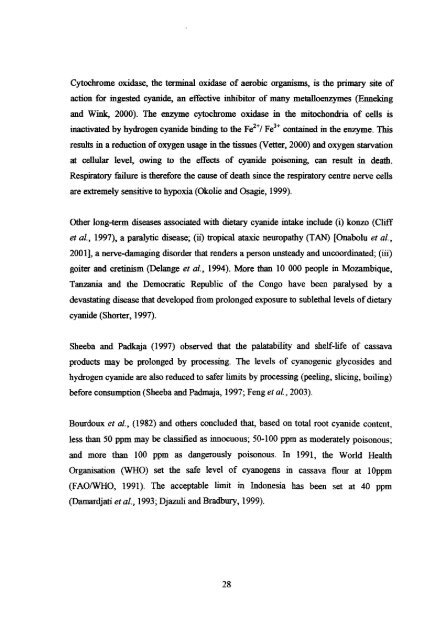ANTI-NUTRITIONAL CONSTITUENT OF COLOCASIA ESCULENTA ...
ANTI-NUTRITIONAL CONSTITUENT OF COLOCASIA ESCULENTA ...
ANTI-NUTRITIONAL CONSTITUENT OF COLOCASIA ESCULENTA ...
You also want an ePaper? Increase the reach of your titles
YUMPU automatically turns print PDFs into web optimized ePapers that Google loves.
Cytochrome oxidase, the terminal oxidase of aerobic organisms, is the primary site of<br />
action for ingested cyanide, an effective inhibitor of many metaIloenzymes (Enneking<br />
and Wink, 2000). The enzyme cytochrome oxidase in the mitochondria of cells is<br />
inactivated by hydrogen cyanide binding to the Fe 2 +J Fe 3 + contained in the enzyme. This<br />
results in a reduction ofoxygen usage in the tissues (Vetter, 2000) and oxygen starvation<br />
at cellular level, owing to the effects of cyanide poisoning, can result in death.<br />
Respiratory failure is therefore the cause of death since the respiratory centre nerve cells<br />
are extremely sensitive to hypoxia (Okolie and Osagie, 1999).<br />
Other long-term diseases associated with dietary cyanide intake include (i) konzo (Cliff<br />
et al., 1997), a paralytic disease; (ii) tropical ataxic neuropathy (TAN) [Onabolu et al.,<br />
2001], a nerve-damaging disorder that renders a person unsteady and uncoordinated; (iii)<br />
goiter and cretinism (Delange et al., 1994). More than 10 000 people in Mozambique,<br />
Tanzania and the Democratic Republic of the Congo have been paralysed by a<br />
devastating disease that developed from prolonged exposure to sublethal levels ofdietary<br />
cyanide (Shorter, 1997).<br />
Sheeba and Padkaja (1997) observed that the palatability and shelf-life of cassava<br />
products may be prolonged by processing. The levels of cyanogenic glycosides and<br />
hydrogen cyanide are also reduced to safer limits by processing (peeling, slicing, boiling)<br />
before consumption (Sheeba and Padmaja, 1997; Feng et al., 2003).<br />
Bourdoux et af., (1982) and others concluded that, based on total root cyanide content,<br />
less than 50 ppm may be classified as innocuous; 50-100 ppm as moderately poisonous;<br />
and more than 100 ppm as dangerously poisonous. In 1991, the World Health<br />
Organisation (WHO) set the safe level of cyanogens in cassava flour at lOppm<br />
(FAOIWHO, 1991). The acceptable limit in Indonesia has been set at 40 ppm<br />
(Damardjati etal., 1993; Djazuli and Bradbury, 1999).<br />
28
















